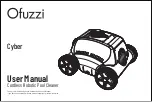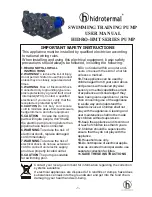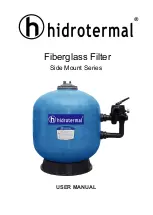
3
Prevent Young Children From Drowning:
Install fencing or approved barrier around all sides of pool.
State or local laws or codes may require fencing or other approved
barriers.
Check state or local laws and codes before setting up pool.
Drowning occurs silently and quickly. Assign an adult to supervise pool
and wear provided water watcher tag.
Keep children in your direct sight when they are in or near pool and
when you are filling and emptying pool.
When searching for a missing child, check pool first, even if you think
your child is in the house.
Pool presents a drowning hazard even during filling and draining of the
pool. Maintain constant supervision of children and do not remove any
safety barriers until the pool is completely empty and stowed away.
Refer to the list of barrier recommendations and guidelines as
described in CPSC Publication No.362.
Assign an adult to be responsible for watching children in the pool.
Give this person a “water watcher” tag and ask that they wear it the
entire time they are in charge of supervising children in the pool. If they
need to leave for any reason, ask this person to pass the “water
watcher” tag and the supervision responsibility to another adult.
Locate pumps and filters in such a way that children cannot climb on
them to gain access to pool.
If you have a ladder, refer to the ladder's manual for instructions.
If you have a pump, refer to the pump's manual for instructions.
Prevent Young Children From Gaining Access to Pool:
Remove pool ladders before leaving pool. Toddlers can climb ladder
and get into pool.
Position furniture away from pool so that children cannot climb and
gain access to pool.
When leaving pool, remove floats and toys from pool that might attract
a child.
Be Prepared to Respond to an Emergency:
Keep a working phone and list of emergency numbers near pool.
Become certified in cardiopulmonary resuscitation (CPR) so you can
respond to an emergency.
Electrocution Risk:
Keep all electrical lines, radios, speakers, and other electrical devices
away from pool.
Do not place pool near or under overhead electrical lines.
Suction Risk:
Replacement pump should never exceed the maximum flow rate
marked on the suction fitting.
For further safety tips check out the following websites:
www.homesafetycouncil.org
http://www.safety-council.org/info/child/water.html
www.safekids.org
www.nspi.org
Safety Barrier Guidelines for Residential Swimming Pool
Section I: Outdoor swimming pool
An outdoor swimming pool, including an inground, aboveground, or
onground pool, hot tub, or spa, should be provided with a barrier which
complies with the following:
1. The top of the barrier should be at least 48 inches above grade
measured on the side of the barrier which faces away from the
swimming pool. The maximum vertical clearance between grade
and the bottom of the barrier should be 4 inches measured on the
side of the barrier which faces away from the swimming pool.
Where the top of the pool structure is above grade, such as an
aboveground pool, the barrier may be at ground level, such as the
pool structure, or mounted on top of the pool structure. Where the
barrier is mounted on top of the pool structure, the maximum
vertical clearance between the top of the pool structure and the
bottom of the barrier should be 4 inches.
2. Openings in the barrier should not allow passage of a 4-inch
diameter sphere.
3. Solid barriers, which do not have openings, such as a masonry or
stone wall, should not contain indentations or protrusions except
for normal construction tolerances and tooled masonry joints.
4. Where the barrier is composed of horizontal and vertical members
and the distance between the tops of the horizontal members is
less than 45 inches, the horizontal members should be located on
the swimming pool side of the fence. Spacing between vertical
members should not exceed 1-3/4 inches in width. Where there are
decorative cutouts, spacing within the cutouts should not exceed
1-3/4 inches in width.
5. Where the barrier is composed of horizontal and vertical members
and the distance between the tops of the horizontal members is 45
inches or more, spacing between vertical members should not
exceed 4 inches. Where there are decorative cutouts, spacing
within the cutouts should not exceed 1-3/4 inches in width.
6. Maximum mesh size for chain link fences should not exceed 1-3/4
inch square unless the fence is provided with slats fastened at the
top or the bottom which reduce the openings to no more than 1-3/4
inches.
7. Where the barrier is composed of diagonal members, such as a
lattice fence, the maximum opening formed by the diagonal
members should be no more than 1-3/4 inches.
8. Access gates to the pool should comply with Section I, Paragraphs
1 through 7,and should be equipped to accommodate a locking
device. Pedestrian access gates should open outward, away from
the pool, and should be self-closing and have a self-latching
device. Gates other than pedestrian access gates should have a
self-latching device. Where the release mechanism of the
self-latching device is located less than 54 inches from the bottom
of the gate, (a) the release mechanism should be located on the
pool side of the gate at least 3 inches below the top of the gate and
(b) the gate and barrier should have no opening greater than 1/2
inch within18 inches of the release mechanism.
9. Where a wall of a dwelling serves as part of the barrier, one of the
following should apply:
(a) All doors with direct access to the pool through that wall should
be equipped with an alarm which produces an audible warning
when the door and its screen, if present, are opened. The alarm
should sound continuously for a minimum of 30 seconds within
7 seconds after the door is opened. Alarms should meet the
requirements of UL2017 General-Purpose Signaling Devices
and Systems, Section 77. The alarm should have a minimum
sound pressure rating of 85 dBA at 10 feet and the sound of the
alarm should be distinctive from other household sounds, such
WARNING
IMPORTANT SAFETY INSTRUCTIONS
Read and Follow All Safety Information
and Instructions.
Keep for future reference.
Failure to follow these warnings and
instructions can result in serious injury or
death to users, especially children.
as smoke alarms, telephones, and door bells. The alarm should
automatically reset under all conditions. The alarm should be
equipped with manual means, such as touchpads or switches,
to temporarily deactivate the alarm for a single opening of the
door from either direction. Such deactivation should last for no
more than 15 seconds. The deactivation touchpads or switches
should be located at least 54 inches above the threshold of the
door.
(b) The pool should be equipped with a power safety cover which
complies with ASTM F1346-91 listed below.
(c) Other means of protection, such as self-closing doors with
self-latching devices, are acceptable so long as the degree of
protection afforded is not less than the protection afforded by
(a) or (b) described above.
10. Where an aboveground pool structure is used as a barrier or where
the barrier is mounted on top of the pool structure, and the means
of access is a ladder or steps, then (a) the ladder to the pool or
steps should be capable of being secured, locked or removed to
prevent access, or (b) the ladder or steps should be surrounded by
a barrier which meets Section I, Paragraphs 1 through 9. When the
ladder or steps are secured, locked, or removed, any opening
created should not allow the passage of a 4-inch diameter sphere.
Section II: Barrier Locations
Barriers should be located so as to prohibit permanent structures,
equipment or similar objects from being used to climb the barriers.
NOTE:
If your purchased pool set do not have any circulation
system, you can purchase separately. But please make sure the
equipment can turn over total volume of pool water no less than once
every 12 hr. You can check the water capacity on packaging to select
suitable circulation system. Pump provided for the circulation of water
shall be tested by a Nationally Recognized Testing Laboratory and
certified to conform to UL1081.
Also make sure the selected suction outlet sold with the pump should
be tested by a Nationally Recognized Testing Laboratory and certified
to conform to ASME/ANSI A112.19.8 or its successor standard
ANSI/APSP-16, in order to prevent suction entrapment.
Please read carefully and keep for future reference.
CHOOSE THE CORRECT LOCATION
The surface chosen to install the pool must respect the following
technical characteristics:
1. Because of the combined weight of the water inside the pool and
the pool users, it is extremely important that the surface chosen to
install the pool is capable of uniformly supporting the total weight
for the entire time the pool is installed. When choosing the surface,
take into consideration that water may come out of the pool when
in use or in the rain. If the water softens the surface, it may lose its
capability to support the pool weight.
2. Check regularly the position of the vertical legs and the U-supports.
They must be on the same level as the bottom of the pool at all
times. If the vertical leg or the U-support starts to sink into the
ground, drain the water immediately to avoid the pool collapsing
WARNING
Keep all electrical lines, radios,
speakers, and other electrical
devices away from pool. Do not
place pool near or under overhead
electrical lines.
Electrocution Risk
Stay away from drains & suction fittings
WARNING
If drain or suction outlet cover is missing or broken, your hair, body,
and jewelry can get sucked into drain. You could be held under
water & drown! Do not use pool if drain or suction outlet cover is
missing or broken.
Prevent Drowning
WARNING
Children under 5 are at highest risk for drowning.
Closely watch children who are
in or near
this pool.
WARNING
You can break your neck and be
paralyzed!
No Diving
due to the uneven loading on the frame structure. Change the
location of the pool or modify the surface material.
3. We recommend positioning the pool away from any objects
children could use to climb into the pool.
4. Position the pool near an adequate drainage system to deal with
overflow or to discharge the pool.
5. The surface must be flat and smooth. If the surface is inclined or
uneven, it can create an unbalanced loading on the structure of the
pool. This situation can damage the welding point of the liner and
bend the frame. In the worst cases, the pool can collapse, causing
serious personal injury and/or damage to personal property.
6. The selected surface must be clear of any type of object. Due to
the weight of the water, any object under the pool could damage or
perforate the bottom of the pool.
7. The selected surface must be clear of aggressive plants and weed
species. Those types of strong vegetation could grow through the
liner and create water leakage. The grass or other vegetation that
may cause odor or slime to develop have to be eliminated from the
set-up location.
8. The selected location must not have overhead power lines or trees.
Be sure the location does not contain underground utility pipes,
lines or cables of any kind.
9. The selected position must be far from house entrance. Do not
position any equipment or other furniture around the pool. The
water that comes out of the pool during the use or due to a faulty
product can damage the furniture inside the house or surrounding
the pool.
10. The selected surface must be flat and without holes that can
damage the material of the liner.
Follow the important instructions above to choose the correct surface
and location to set up your pool. Damaged parts of the pool, due to the
fact that the set-up surface and location does not match the
instructions, will not be considered as manufacture defect and will
avoid the warranty and any service claims.
Suggested set-up surfaces:
grass, ground, concrete, and all other
surfaces that respect the above set-up conditions.
Not suggested surfaces:
mud, sand, gravel, deck, balcony, driveway,
platform, soft/loose soil or other surface that does not meet the above
set-up conditions.
NOTE:
Check with your local city council for by-laws relating to
fencing, barriers, lighting and safety requirements and ensure you
comply with all laws.
NOTE:
If have a filter pump, refer to the pump’s manual for
instructions.
NOTE:
The ladder must match the pool size and should be
used only for entering and exiting the pool. It is forbidden to exceed the
permitted payload of the ladder. Check regularly if the ladder is
properly assembled.


































